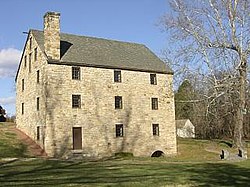George Washington's Gristmill
|
George Washington’s Distillery and Gristmill
|
|

Reconstruction of Washington’s Gristmill
|
|
| Location | 5512 Mount Vernon Memorial Hwy., Lorton, Virginia, USA |
|---|---|
| Coordinates | 38°42′46″N 77°07′51″W / 38.71278°N 77.13083°WCoordinates: 38°42′46″N 77°07′51″W / 38.71278°N 77.13083°W |
| Area | 6.7 acres (2.7 ha) |
| Built | 1770; reconstructed in 1933 |
| Architect | Burson, R.E. (1933 reconstruction) |
| Architectural style | Colonial Revival |
| NRHP Reference # | 03000739 |
| VLR # | 029-0330 |
| Significant dates | |
| Added to NRHP | August 8, 2003 |
| Designated VLR | March 19, 2003 |
George Washington’s Gristmill was part of the original Mount Vernon plantation, constructed during the lifetime of the United States' first president. The original structure was destroyed about 1850. The Commonwealth of Virginia and the Mount Vernon Ladies’ Association have reconstructed the gristmill and the adjacent distillery. The reconstructed buildings are located at their original site three miles (5 km) west of Mount Vernon proper near Woodlawn Plantation in Alexandria, Virginia. Because the reconstructed buildings embody the distinctive characteristics of late eighteenth century methods of production and are of importance to the history of Virginia, the site is listed on the National Register of Historic Places despite the fact that the buildings are not original.
George Washington inherited Mount Vernon in 1754. In 1771 he erected a large stone gristmill on the plantation to replace a mill his father had built in the 1730s. The new mill was located three miles (5 km) west of Mount Vernon on Dogue Run Creek. It was used to produce flour and cornmeal for the plantation as well as high-quality flour for export to the West Indies, England, and continental Europe. Washington also built a house for the miller and a cooperage to supply barrels for the mill, and later, the distillery operation. The mill was powered by a large water wheel. To ensure a steady power supply, water was diverted from Piney Branch into Dogue Run Creek above the mill's headrace. The additional waterflow significantly increased the mill’s production capacity. In 1791 Washington automated his mill using technology developed and patented by Oliver Evans of Delaware. Evans was personally acquainted with the mill and had repaired some of its works.
...
Wikipedia



